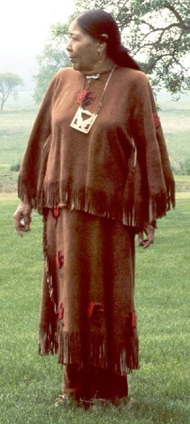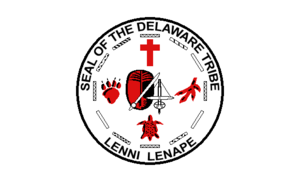Delaware Tribe of Indians facts for kids
The Delaware Tribe of Indians is a Native American tribe. They are also known as the Lenape people. Their main office is in Bartlesville, Oklahoma. This tribe is one of three federally recognized tribes of Lenape people in the United States. The other two are the Delaware Nation in Anadarko, Oklahoma, and the Stockbridge-Munsee Community in Wisconsin. Many Lenape people also live in Canada.
Contents
Joining the Tribe
To become a member of the Delaware Tribe, you must be a descendant of someone listed on the 1906 tribal rolls. These rolls were records of Delaware people living in Indian Territory at that time. There are no rules about how much "Native American blood" a person needs to have.
Culture and Traditions
The Council of Lenape Elders works hard to keep their traditions alive. They help preserve traditional dances, their unique culture, and the tribal language. They also work with the Delaware Gourd Society.
The tribe has a special place called the Delaware Center. It is on an 80-acre (320,000 m2) piece of land in Bartlesville. Delaware artists are well-known for their amazing wood carving and ribbon work skills.
A Look at History
The Delaware people speak an Algonquian language. They call themselves Lenni Lenape. This means "Original People." When Europeans first arrived in the early 1600s, the tribe lived along the Delaware River. This river was named after Lord de la Warr. Their lands were in what is now New York, eastern New Jersey, and western Long Island, New York.
The Delaware Nation was the first Native American group to sign a treaty with the new United States. They signed this important agreement on September 17, 1778. Even with the treaty, the Delaware were forced to leave their Eastern lands. They moved first to Ohio, then to Indiana (Plainfield), Missouri, Kansas, and finally to Indian Territory.
Some Delaware ancestors, like those of the Delaware Nation, moved to Anadarko. Other Delaware groups moved north with the Iroquois after the American Revolutionary War. They formed two reserves in Ontario, Canada.
Historically, the Delaware people had three main groups. These were the Munsee, Unami, and Unalachtigo. These groups were based on their language and where they lived.
Federal Recognition Journey
Being "federally recognized" means the U.S. government officially sees a tribe as a sovereign nation. This allows for government-to-government dealings.
First Recognition and Challenges
In 1867, the ancestors of the Delaware Tribe of Indians agreed to move. They relocated to the Cherokee Nation in what was then Indian Territory. The Delaware Tribe of Indians managed their own affairs within the Cherokee Nation's lands.
In 1974, the Bureau of Indian Affairs (BIA) approved changes to the Delaware Tribe's rules. This meant the tribe was officially recognized. However, another group, the Kansas Delaware, sued. The BIA then reviewed all Delaware tribes' documents. In 1979, the BIA decided to remove the Delaware Tribe of Indians' recognition. They said that moving to Oklahoma with the Cherokees meant the Delaware were under the Cherokee Nation's authority. The BIA decided they would only work with the Delaware Tribe through the Cherokee Nation.
Regaining Recognition
The Delaware Tribe of Indians regained their federal recognition in 1991. The BIA changed its 1979 decision. But the Cherokee Nation disagreed. They sued the BIA. A court sided with the Cherokee Nation, and the Delaware Tribe lost its federal recognition again in 2004.
After many years of talks, the two tribes reached an agreement in October 2008. Delaware voters approved this agreement. They voted to reorganize in May 2009, using the rules of the Oklahoma Indian Welfare Act.
Official Recognition Again
On July 28, 2009, the U.S. Department of the Interior sent a notice to the tribal office in Bartlesville. This notice confirmed that the Delaware Tribe was once again officially recognized by the U.S. government.
Important Tribal Members
- Nora Thompson Dean (Touching Leaves Woman, 1907–1984) – She was a traditionalist, an expert in plant medicine (herbalist), and a language teacher.
- Charles Journeycake (Ne-Sha-Pa-Na-Cumin, December 16, 1817 - January 3, 1894) – In 1861, Journeycake became the main Chief of the Delaware tribe.
- Joanne Barker – She is a professor and an author.



